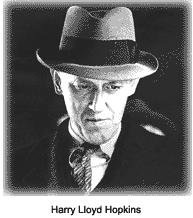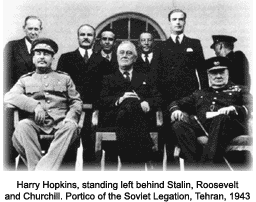The distinguished life and career of Harry Lloyd Hopkins in the first half of the 20th century lay at the core of major social changes that defined modern America in the latter 20th and early 21st centuries. Hopkins began his career as a 22-year-old social worker in the ghettos of New York. He eventually rose to a close working relationship with President Franklin D. Roosevelt and his wife, Eleanor Roosevelt.
 Hopkins was the principal architect of FDR's New Deal and was the president's political "point man." In that role, Hopkins performed as liaison and negotiator between FDR, Britain's Winston Churchill and the Soviet Union's Joseph Stalin. Working with Eleanor Roosevelt, Hopkins hammered out the logistics and operations of New Deal programs conceived by the "Brain Trust" of academics and social policy experts.
Hopkins was born on August 17, 1890 at Sioux City, Iowa, the fourth child of David and Anna (Pickett) Hopkins. He was reared in Grinnell, Iowa, and graduated from Grinnell College in 1912. He married Ethel Gross in October 1913, and the couple produced three sons.
Grinnell was a prosperous, small prairie town with progressive religious values. The community economy was based upon agriculture and the citizenry were primarily Protestant. Indeed, Grinnell clergy, influenced by the Social Gospel Reform Movement, founded Grinnell College. Academic programs offered by the school also reflected those principals and values. Basically, those values held that every man is his brother's keeper.
Soon after graduation from Grinnell College, Hopkins accepted employment at the Christadora House, an "Intentional Community" in New York City's Lower East Side ghetto. Soon, he accepted a position with the New York-based Association for Improving the Conditions of the Poor, (AICP). Starting in the position of "friendly visitor," Hopkins became the superintendent of the Employment Bureau for that agency. In 1915, New York Mayor John P. Mitchell appointed Hopkins to the position of secretary in the Bureau of Child Welfare.
Around the time of America's entry into World War I (1917), Hopkins moved his family to New Orleans, where he worked as director of Civilian Relief, American Red Cross Gulf Division. He was appointed general manager in 1921. Hopkins facilitated the draft of a charter for the American Association of Social Workers (AASW), and was elected its president in 1923. Returning to New York City in 1922, Hopkins assumed the position of general director of the New York Tuberculosis Association (NYTA), and it grew enormously.
Hopkins was the principal architect of FDR's New Deal and was the president's political "point man." In that role, Hopkins performed as liaison and negotiator between FDR, Britain's Winston Churchill and the Soviet Union's Joseph Stalin. Working with Eleanor Roosevelt, Hopkins hammered out the logistics and operations of New Deal programs conceived by the "Brain Trust" of academics and social policy experts.
Hopkins was born on August 17, 1890 at Sioux City, Iowa, the fourth child of David and Anna (Pickett) Hopkins. He was reared in Grinnell, Iowa, and graduated from Grinnell College in 1912. He married Ethel Gross in October 1913, and the couple produced three sons.
Grinnell was a prosperous, small prairie town with progressive religious values. The community economy was based upon agriculture and the citizenry were primarily Protestant. Indeed, Grinnell clergy, influenced by the Social Gospel Reform Movement, founded Grinnell College. Academic programs offered by the school also reflected those principals and values. Basically, those values held that every man is his brother's keeper.
Soon after graduation from Grinnell College, Hopkins accepted employment at the Christadora House, an "Intentional Community" in New York City's Lower East Side ghetto. Soon, he accepted a position with the New York-based Association for Improving the Conditions of the Poor, (AICP). Starting in the position of "friendly visitor," Hopkins became the superintendent of the Employment Bureau for that agency. In 1915, New York Mayor John P. Mitchell appointed Hopkins to the position of secretary in the Bureau of Child Welfare.
Around the time of America's entry into World War I (1917), Hopkins moved his family to New Orleans, where he worked as director of Civilian Relief, American Red Cross Gulf Division. He was appointed general manager in 1921. Hopkins facilitated the draft of a charter for the American Association of Social Workers (AASW), and was elected its president in 1923. Returning to New York City in 1922, Hopkins assumed the position of general director of the New York Tuberculosis Association (NYTA), and it grew enormously.
Soon noticed by then New York governor Franklin Roosevelt, Hopkins was asked to run the first state relief organization in the nation, the Temporary Emergency Relief Administration (TERA). By the time FDR gained the presidency in 1933, 25 percent of the American work force was unemployed, in spite of former President Hoover's eventual recognition of the depth of the continuing economic depression. Hopkins was recruited into FDR's Brain Trust, which included several of Hopkins’s Grinnell College alumni. Hopkins served as Secretary of Commerce from 1938 to 1940.
With the national stage set for massive changes, the Brain Trust explored economic and social policies that would begin to stabilize the American economy. Taking America off the Gold Standard, creating the Emergency Banking Act/Federal Deposit Insurance Corporation (FDIC) are but two examples. They also created policies to provide direct aid to Americans through the new Federal Emergency Relief Administration, (FERA). Hopkins was the first chief of FERA.
The FDR administration soon increased funds to FERA, and added additional programs to get people back to work and revitalize the American economy. Hopkins and the Brain Trust were criticized for excessive spending by conservative members of Congress, who claimed that the economy would sort itself out in the long run. To which Hopkins replied, "People don't eat in the long run, they eat every day." There were other sinister forces to the left of the Democratic Party that concerned FDR. Louisiana U.S. Senator and firebrand populist Huey P. Long believed FDR had not gone far enough to help America’s poor, and the Communist Party was gaining political ground at the time.
Hopkins worked closely with the First Lady to promote and defend other relief agencies that include the Civil Works Administration (CWA), the Federal Surplus Relief Administration, (FSRA), the Works Progress Administration (WPA) and the Tennessee Valley Authority (TVA). Most of those programs existed to the end of their usefulness, some were challenged in court and eventually cancelled, but the TVA remains a powerful and accepted agency to this day. The National Labor Relations Act, (Wagner Act, 1935), which instituted collective bargaining in the workplace, and the creation of the Social Security Administration, were two of the most powerful and durable programs of the New Deal.
While most of the work force existed in the East, most of the projects were in the West. Many of America's hospitals, municipal swimming pools, parks, highways, bridges, dams and unique structures, dating to those days, remain in use today. For example, the WPA's Federal Theater Project (Library of Congress) stands as a cultural monument; the FERA and the CCC produced the Golden Gate Bridge, Bonneville Dam, Hoover Dam and thousands of other projects across the land.
 As FDR's point man or unofficial emissary, Winston Churchill held Hopkins in high esteem, once remarking, "He was the most faithful and perfect channel of communication between the president and me." And in reference to Hopkins' grasp and appreciaton of Europe’s struggles with Germany, Churchill said, "It was to be the defeat, ruin and slaughter of Hitler to the exclusion of all other purposes, loyalties, or aims."
Such critiques of Roosevelt and Hopkins as the notorious book, Verona Secrets, paint Hopkins as a Russian spy. No such allegation has been substantiated or proven.
Hopkins died in early 1946, succumbing to a long and debilitating illness.
As FDR's point man or unofficial emissary, Winston Churchill held Hopkins in high esteem, once remarking, "He was the most faithful and perfect channel of communication between the president and me." And in reference to Hopkins' grasp and appreciaton of Europe’s struggles with Germany, Churchill said, "It was to be the defeat, ruin and slaughter of Hitler to the exclusion of all other purposes, loyalties, or aims."
Such critiques of Roosevelt and Hopkins as the notorious book, Verona Secrets, paint Hopkins as a Russian spy. No such allegation has been substantiated or proven.
Hopkins died in early 1946, succumbing to a long and debilitating illness.